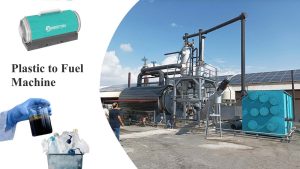In the epoch of environmental consciousness, the metamorphosis of waste into a valuable resource is no longer a fanciful concept. At the nexus of innovation and sustainability lies the process of plastic to fuel, a dynamic journey that transcends the conventional trajectory of plastic waste. Here, we delve into the intricate realms of this transformative process, guided by the precision of a sophisticated plastic to fuel machine.
The Alchemy of Transformation
The alchemical metamorphosis commences within the confines of the plastic to fuel machine, where plastic waste undergoes a profound conversion. This isn’t mere disposal; it’s a meticulous disassembly at the molecular level, a pyrolytic journey that extracts the latent energy embedded in plastic polymers.
As the plastic succumbs to the controlled pyrolytic conditions, it sheds its synthetic identity. The molecular bonds fracture, yielding a spectrum of hydrocarbons that form the bedrock of a new energy paradigm. This isn’t just fuel production; it’s a symbiosis of waste management and energy generation, a harmonious convergence of environmental stewardship and resource efficiency.
Unveiling Liquid Gold
The outputs of this pyrolytic symphony are often referred to as liquid gold – a poetic nod to the transformative potential within. This liquid gold, derived from the ingeniously crafted plastic to fuel machine, embodies the essence of circularity. It transcends the linear trajectory of plastic waste, presenting itself as a versatile resource with applications spanning fuel production to chemical synthesis.
The liquid gold, essentially a refined form of pyrolysis oil, stands as a testament to the ingenuity of harnessing energy from waste. Its composition renders it a potent precursor for fuels, enabling a sustainable alternative to conventional fossil fuels. In a world grappling with energy transitions, the journey from plastic waste to liquid gold becomes a beacon of hope.
Beyond Waste Disposal: Environmental Guardianship
The significance of plastic to fuel extends beyond the realm of waste disposal. It assumes the mantle of environmental guardianship, combating the dual menace of plastic pollution and the dependence on finite fossil resources. The controlled pyrolysis within the plastic to oil machine not only diverts plastics from landfills but also mitigates the environmental toll of conventional waste disposal methods.
This isn’t just an industrial process; it’s a strategic maneuver in the battle against climate change. By transforming plastic waste into a viable fuel source, we navigate towards a future where waste is not a burden but a reservoir of untapped energy potential.
The Precision of Technology: Plastic to Fuel Machine
Central to this transformative odyssey is the precision of technology encapsulated in the plastic to fuel machine. This apparatus is more than a mere assembly of components; it’s a testament to engineering finesse. From the controlled heating elements to the catalytic converters that refine the pyrolysis outputs, each facet of this machine is calibrated to extract maximum value from plastic waste.
The intricacies of the pyrolytic process demand a machine that not only withstands high temperatures but orchestrates them with a symphony of control. The plastic to fuel pyrolysis machine is a choreographer of molecular rearrangements, a guardian of efficiency, ensuring that every bit of plastic undergoes a metamorphosis into a resource-rich liquid gold.

Economic Resilience in Resource Recovery
Beyond the realms of environmental stewardship, plastic to fuel embodies economic resilience in resource recovery. The outputs from the process extend beyond fuel production; they include valuable by-products such as waxes and gases with applications in various industries. The residue left behind, often carbon black, finds utility in construction and manufacturing. This economic valorization of plastic waste challenges the traditional narrative of waste as a liability. In the crucible of the plastic to fuel machine, plastic waste becomes a resource with economic potential, fostering a circular economy where residues are not discarded but repurposed.